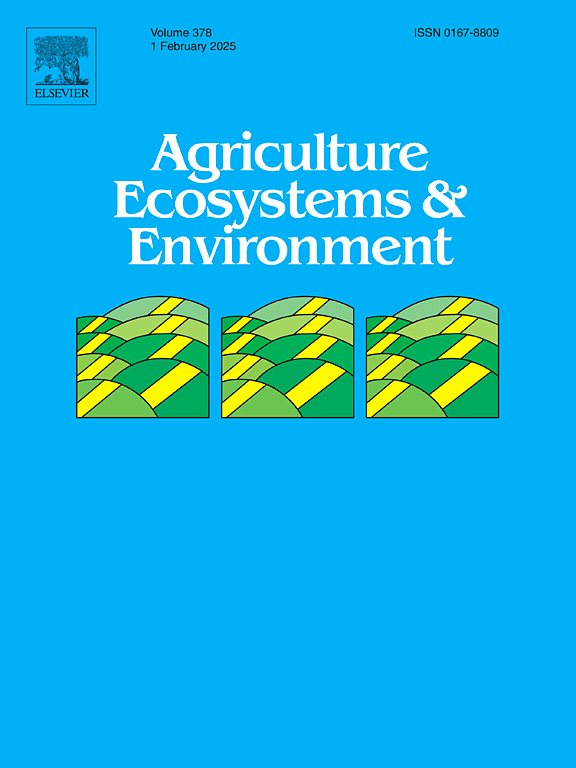华盛顿州东部免耕、有机和混合作物牲畜系统的土壤健康和生态恢复力
IF 6.4
1区 农林科学
Q1 AGRICULTURE, MULTIDISCIPLINARY
引用次数: 0
摘要
结合土壤健康和生态恢复力的概念为评估和确定可持续土壤管理战略提供了一个有用的框架。全球和华盛顿州东部帕卢斯地区的主要土壤健康问题包括侵蚀、有机质(SOM)损失和酸化。替代种植制度有可能通过免耕、多样化轮作和减少化学品投入等做法改善这些地区的土壤健康。在这里,我们报告了一项为期9年的研究(2012-2020),研究了Palouse的四种替代农业系统及其对土壤健康和生态恢复力的影响,考虑了土壤侵蚀、SOM枯竭、酸化和财务绩效。这四种制度包括:(i)免耕制度(NT),采用典型的3年春豆-冬小麦-春小麦轮作,常规使用除草剂和肥料;(ii)采用3年豌豆-冬小麦-春小麦轮作的混合作物-牲畜系统(MIX),结合牲畜,减少除草剂和肥料的使用;(iii)一个有机系统,将羊和间作与三年的苜蓿/草干草和六年的谷物和豆类(有机作物)结合起来;(iv)一个有机系统,将羊整合到8年轮作中,6年轮作苜蓿/草干草,2年轮作谷物和豆类(ORGhay)。4种耕作方式均高于土壤侵蚀的最大生态恢复阈值,低于土壤有机碳含量的最小阈值,高于酸化的最小阈值,高于经济效益的最小阈值。在控制侵蚀方面,NT效果最好,ORGhay次之,MIX次之,ORGcrop次之。在碳储量方面,ORGhay表现最好,因为它是唯一不减少表面(0-15 cm) SOC的系统。在酸化条件下,有机作物和有机干草在表层(0-7.5 cm)的表现优于NT和MIX,但在0-30 cm时,所有耕作制度的表现相似。在经济方面,有机干草在九个生长季节的平均净收益最高,其次是有机作物,混合,然后是NT,假设所有四种系统都优于该地区典型的传统耕作农场。有机干草没有重大的权衡,总体上表现最好,与其他种植制度相比,在所有测量区域具有相似或改善的生态恢复力。这项研究的数据表明,帕卢斯农民可能会受益于将一小部分田地转化为有机苜蓿/干草混合物。然而,由于涉及风险,可能需要激励农民实施这一措施。本文章由计算机程序翻译,如有差异,请以英文原文为准。
Soil health and ecological resilience of no-till, organic, and mixed-crop livestock systems in eastern Washington State
Combining concepts of soil health and ecological resilience provides a useful framework for assessing and identifying sustainable soil management strategies. Major soil health concerns globally and in the Palouse region of eastern Washington State include erosion, organic matter (SOM) loss, and acidification. Alternative cropping systems have the potential to improve these areas of soil health through practices such as no-tillage, diversified rotations, and reduced chemical inputs. Here, we report on a 9-year study (2012–2020) examining four alternative farming systems in the Palouse and their impacts on soil health and ecological resilience, accounting for soil erosion, SOM depletion, acidification, and financial performance. The four systems included (i) a no-till system (NT) using a typical 3-year spring pea-winter wheat-spring wheat rotation with conventional herbicide and fertilizer use; (ii) a mixed crop-livestock system (MIX) using a 3-year pea-winter wheat-spring wheat rotation with livestock integration and reduced herbicide and fertilizer use; (iii) an organic system that integrates sheep and intercropping with three years of alfalfa/grass hay and six years of grain cereals and legumes (ORGcrop); and (iv) an organic system that integrates sheep into an eight-year rotation with six years of alfalfa/grass hay and two years of grain cereals and legumes (ORGhay). All four farming systems were above the maximum ecological resilience threshold for soil erosion, below the minimum threshold for soil organic carbon (SOC) content, above the minimum threshold for acidification, and above the minimum threshold for economic performance. In terms of erosion control, NT performed the best, followed by ORGhay, MIX, and then ORGcrop. In terms of carbon stock, ORGhay performed the best as it was the only system to not decrease in surface (0–15 cm) SOC. With acidification, ORGcrop and ORGhay performed better than NT and MIX at the surface (0–7.5 cm), but all farming systems were similar when considering 0–30 cm. With economics, ORGhay had the highest average net returns across the nine growing seasons, followed by ORGcrop, MIX, and then NT, with all four systems hypothetically outperforming a typical conventional tillage farm in the area. ORGhay had no major tradeoffs and overall performed best, having similar or improved ecological resilience in all areas measured compared to the other cropping systems. The data from this study suggests that Palouse farmers may benefit in converting a small percentage of their fields to organic alfalfa/hay mixtures. However, farmers may need to be incentivized to implement this due to the risk involved.
求助全文
通过发布文献求助,成功后即可免费获取论文全文。
去求助
来源期刊

Agriculture, Ecosystems & Environment
环境科学-环境科学
CiteScore
11.70
自引率
9.10%
发文量
392
审稿时长
26 days
期刊介绍:
Agriculture, Ecosystems and Environment publishes scientific articles dealing with the interface between agroecosystems and the natural environment, specifically how agriculture influences the environment and how changes in that environment impact agroecosystems. Preference is given to papers from experimental and observational research at the field, system or landscape level, from studies that enhance our understanding of processes using data-based biophysical modelling, and papers that bridge scientific disciplines and integrate knowledge. All papers should be placed in an international or wide comparative context.
 求助内容:
求助内容: 应助结果提醒方式:
应助结果提醒方式:


